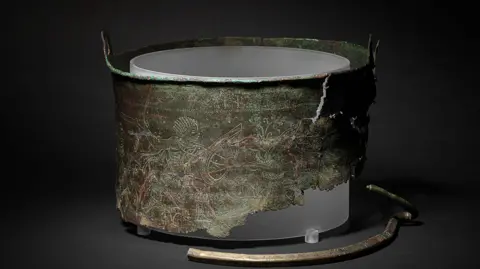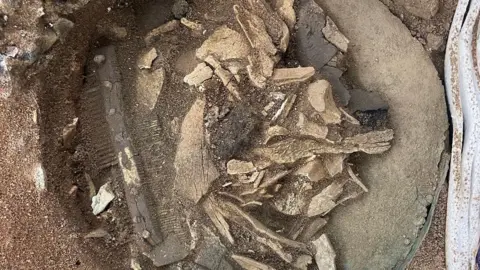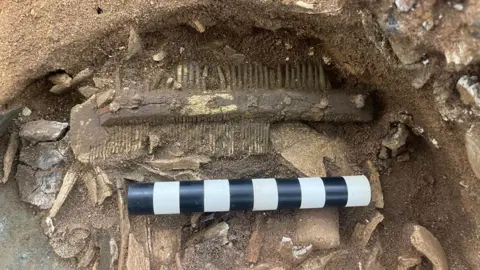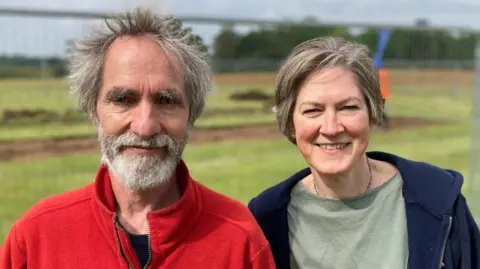Sutton Hoo bucket believed to be cremation vessel
 David Brunetti/National Trust
David Brunetti/National TrustA 6th Century Byzantine bucket that has been pieced back together is believed to have been a cremation vessel, according to archaeologists.
Fragments of the bucket were first discovered at Sutton Hoo, Suffolk, in 1986 with more found in 2012 and last year.
Archaeologists have revealed that cremated human and animal bones were found within the base of the bucket, with the human remains believed to belong to an "important person" in the community.
Angus Wainwright, National Trust archaeologist, said he hoped further analysis would "uncover more information about this very special burial".
 FAS Heritage/National Trust
FAS Heritage/National TrustThe TV show Time Team found pieces of the bucket last year, as part of a two-year research project with FAS Heritage and the National Trust exploring the earlier history of the site.
The copper alloy bucket, decorated with a hunting scene, is thought to have been made several decades before the famous Sutton Hoo ship and its treasures were buried at the site.
The human bones found in last year's dig included part of an ankle bone and fragments of skull.
While the sex could not be determined, it is hoped that ancient DNA from the owner might have survived on an unburnt comb that was discovered.
Animal bones that were found belonged to a species larger than a pig. Horses were often included on early Anglo-Saxon cremation pyres as a sign of status.
The bucket base and comb will now be carefully conserved to allow further study and reconstruction.
 FAS Heritage/National Trust
FAS Heritage/National Trust"We knew that this bucket would have been a rare and prized possession back in Anglo-Saxon times, but it's always been a mystery why it was buried," Mr Wainwright said.
"Now we know it was used to contain the remains of an important person in the Sutton Hoo community.
"I'm hopeful that further analysis will uncover more information about this very special burial."
 Luke Deal/BBC
Luke Deal/BBCHelen Geake, Time Team's Anglo-Saxon expert, said the "puzzle" of the bucket had "finally" been solved.
"It's a remarkable mixture - a vessel from the southern, classical world containing the remains of a very northern, very Germanic cremation," she said.
"It epitomises the strangeness of Sutton Hoo - it has ship burials, horse burials, mound burials and now bath-bucket burials.
"Who knows what else it might still hold?"
Time Team's Sutton Hoo findings can be watched on YouTube in a four-part documentary titled The Sutton Hoo Dig.
Follow Suffolk news on BBC Sounds, Facebook, Instagram and X.
